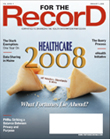January 7, 2008
 Coding for Esophageal Cancer
Coding for Esophageal Cancer
For The Record
Vol. 20 No. 1 P. 28
Esophageal cancer is a form of cancer that starts in the inner layer of the esophagus. Because it is rare to have symptoms related to esophageal cancer in the early stages, it typically is not detected until the more advanced stages. However, close monitoring of Barrett’s esophagus (530.85), which is associated with an increased risk of developing adenocarcinoma of the esophagus, can help detect esophageal cancer sooner. Gastrointestinal reflux disease (530.81) is considered the main cause of Barrett’s esophagus.
Signs and Symptoms
Symptoms do not usually occur in the early stages of esophageal cancer. More advanced cases have the following symptoms:
• difficulty swallowing (dysphagia);
• feeling of food getting stuck in throat;
• unintentional weight loss;
• pain in throat, midchest and between shoulder blades;
• hoarseness;
• hiccups; and
• vomiting up blood.
Types of Esophageal Cancer
The following are the most common types of esophageal cancer:
• Squamous cell or epidermoid carcinoma develops in the squamous cells that line the esophagus.
• Adenocarcinoma originates in the glandular tissue in the distal portion of the stomach.
Rare forms of esophageal cancer include the following:
• Sarcoma;
• Lymphoma;
• Small cell carcinoma;
• Spindle cell carcinoma; and
• Metastasis to esophagus typically from breast or lung.
Esophageal cancer is classified to ICD-9-CM category 150. The fourth digit identifies the site of the cancer as follows:
• 150.0, Cervical esophagus;
• 150.1, Thoracic esophagus;
• 150.2, Abdominal esophagus;
• 150.3, Upper third of esophagus, proximal third of esophagus;
• 150.4, Middle third of esophagus;
• 150.5, Lower third of esophagus, distal third of esophagus;
• 150.8, Other specified part, malignant neoplasm of contiguous or overlapping sites of esophagus whose point of origin cannot be determined; and
• 150.9, Esophagus, unspecified.
Complications
The following are some of the more common complications that may occur with esophageal cancer:
• Tracheoesophageal fistula (530.84), a hole between the esophagus and windpipe.
• Esophageal obstruction (530.3) due to the growth of tumor. According to Coding Clinic, when a patient is admitted with obstruction due to malignancy, the malignancy is sequenced as the principal diagnosis (AHA Coding Clinic for ICD-9-CM, 1997, second quarter, page 3).
Diagnosis
Along with performing a complete history and physical examination, the physician may order the following tests to confirm the diagnosis of esophageal cancer:
• Barium swallow (esophagram) to detect a tumor.
• Esophagoscopy (upper endoscopy) to visualize a tumor in the esophageal wall.
Staging
During the staging process, the physician may order an additional series of tests to determine the extent of the disease. The additional tests may include:
• Bronchoscopy to determine if the cancer has spread to the lungs and/or the trachea.
• Computerized tomography scan to confirm the exact location of the tumor and whether the cancer has spread to nearby lymph nodes or other organs.
• Endoscopic ultrasound to determine how far the cancer has spread into nearby tissues.
• Positron emission tomography scan to detect the location of the tumors.
The following are the stages of esophageal cancer:
• Stage 0 – cancer hasn’t spread to other parts of the body. Includes carcinoma in situ or noninvasive cancer.
• Stage I – cancer occurs in the top layer of the cells lining the esophagus.
• Stage II – cancer has invaded deeper layers of the esophagus lining and may also have spread to nearby lymph nodes.
• Stage III – cancer has spread deeper into the esophagus wall and to nearby tissues or lymph nodes.
• Stage IV – cancer has spread to other parts of the body.
Treatment
Treatment of esophageal cancer depends on type, location, and stage of cancer, as well as the patient’s overall health. Surgery is the most common treatment for esophageal cancer. Surgery may include the following:
• Esophagectomy (excision of esophagus and nearby lymph nodes).
• Esophagogastrectomy (removes the esophagus, nearby lymph nodes, and the upper part of stomach).
Chemotherapy and radiation therapy may also be used to treat esophageal cancer.
Coding and sequencing for esophageal cancer are dependent upon the physician documentation in the medical record and application of the Official Coding Guidelines for inpatient care. Also, use specific AHA Coding Clinic for ICD-9-CM and American Medical Association CPT Assistant references to ensure complete and accurate coding.
— This information was prepared by Audrey Howard, RHIA, of 3M Consulting Services. 3M Consulting Services is a business of 3M Health Information Systems, a supplier of coding and classification systems to nearly 5,000 healthcare providers. The company and its representatives do not assume any responsibility for reimbursement decisions or claims denials made by providers or payers as the result of the misuse of this coding information. More information about 3M Health Information Systems is available at www.3mhis.com or by calling 800-367-2447.



